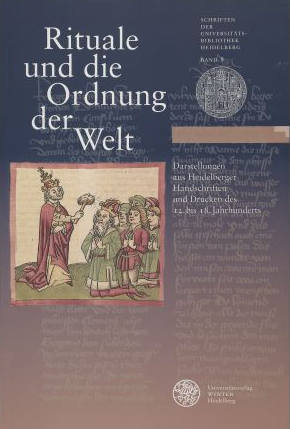Meyer, Carla
Rituale und die Ordnung der Welt: Darstellungen aus Heidelberger Handschriften und Drucken des 12. bis 18. Jahrhunderts
Rituale ordnen die Welt. Dies gilt insbesondere für jene Epochen wie das Mittelalter und die Frühe Neuzeit, in denen keine geschriebenen Verfassungen, Gesetzesbücher und Verwaltungsordnungen das Zusammenleben der Menschen regelten. Als wiederholbare, symbolisch aufgeladene Akte bildeten Rituale soziale Ordnung und legitime Herrschaft nicht nur ab, sondern stellten Autorität, Vorrang und Hierarchie überhaupt erst her. Die Bedeutung der Rituale für die europäischen Gesellschaften der Vormoderne spiegelt sich in der Aufmerksamkeit, die ihnen die Zeitgenossen in Texten und Bildern schenkten. Der Band zeigt die Macht des Rituals in Politik, Religion, Gesellschaft und Recht am Beispiel von Handschriftenminiaturen, Holzschnitten und Drucken des 12. bis 18. Jhds. aus den Tresoren der Universitätsbibliothek Heidelberg.
Weitere Informationen und "Virtuelle Ausstellung".
Der Codex Manesse und die Entdeckung der Liebe: Eine Ausstellung der Universitätsbibliothek Heidelberg, des Instituts für Fränkisch-Pfälzische Geschichte und Landeskunde sowie des Germanistischen Seminars der Universität Heidelberg zum 625. Universitätsjubiläum
Saget mir ieman, waz ist minne? Diese Frage des Dichters Walther von der Vogelweide nach dem Wesen der Liebe beschäftigte seit dem hohen Mittelalter fahrende Sänger, Adlige und sogar Kleriker. Wie in einer Vielzahl von Texten und Bildern immer neu reflektiert wurde, konnte es einem Ritter nicht mehr genügen, die von ihm begehrte Dame zu besitzen. Er wollte vielmehr ihr Herz erobern. Die vielstimmige Entdeckung des Themas 'Minne' als erotischer Liebe zwischen Mann und Frau beeinflusste nicht nur das Verhältnis zwischen den Geschlechtern. Sie wandelte auch das Selbstverständnis des Adels und die Umgangsformen innerhalb der höfischen Gesellschaft.
Die Lieder und Bilder im Codex Manesse fangen diesen Wandel exemplarisch ein. In einzigartiger Weise versammelt die großformatige Prachthandschrift den staufischen wie auch den nachklassischen Minnesang in seiner ganzen Gattungs- und Formenvielfalt. Die Miniaturen zu den Dichtern mit ihren Darstellungen höfischer Szenen, Festlichkeiten und Turniere prägten nachhaltig das moderne Bild des ritterlichen Mittelalters. Dabei ist der Codex Manesse selbst bereits als Rückblick zu deuten: Er wollte die allmählich verklingenden, zuvor nur mündlich überlieferten Lieder erstmals schriftlich zusammentragen; viele Texte wären ohne diese Niederschrift heute verloren.
Am Beispiel des Codex Manesse und weiterer wertvoller Handschriften und Drucke aus den Tresoren der Universitätsbibliothek Heidelberg illustriert der Katalog die Entdeckung der Liebe im hohen Mittelalter.
Weitere Informationen und „Virtuelle Ausstellung“.
Leben Dinge Texte: Begleitheft zur Ausstellung des Sonderforschungsbereichs 933 „Materiale Textkulturen“
Die Ausstellung „LEBEN DINGE TEXTE“ stellt Dinge vor, auf denen etwas geschrieben steht. Die Exponate stammen aus Gesellschaften vor der Erfindung des Buchdrucks: Keilschrifttafeln aus Mesopotamien, antike Graffiti, magische Papyrus-Amulette, gestempelte Dachziegeln, eine Hundeleine mit Edelstein-Inschrift - an solchen 'schrifttragenden Artefakten' kann untersucht werden, wie sich Beschreibstoffe auf die Bedeutung der Texte auswirken und umgekehrt. Außerdem zeigt sich, wie Schrift nicht nur gelesen wird, sondern vielfältig mit Handlungen verbunden und in Rituale eingebettet war.
Der Sonderforschungsbereich 933 „Materiale Textkulturen“ zeigt in dieser Ausstellung Zwischenergebnisse seiner Arbeit. Der SFB 933 wird von der Deutschen Forschungsgemeinschaft gefördert und vereint über 50 Wissenschaftlerinnen und Wissenschaftler der Ruprecht-Karls-Universität Heidelberg und der Hochschule für Jüdische Studien Heidelberg.





